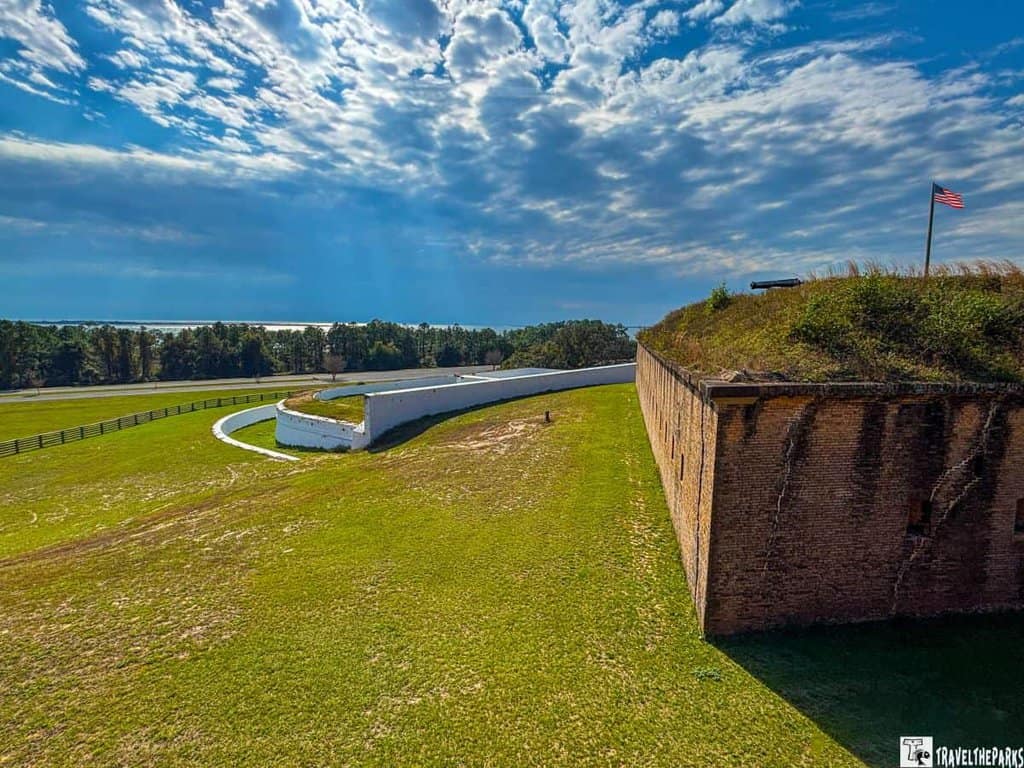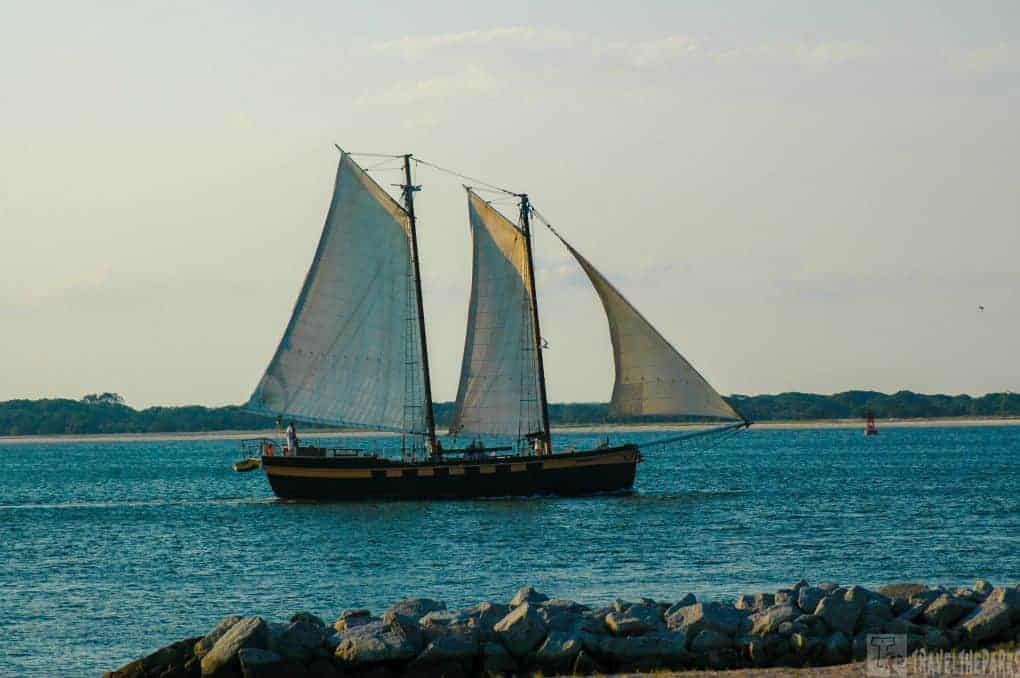There’s a unique joy in discovering new places that offer breathtaking views and rich history, such as exploring Fort Barrancas Historic Site. Each spot holds stories waiting to be uncovered. The thrill of standing in a place where events shaped the past is unmatched. Whether it’s a hidden trail or a historic building, each visit adds to our understanding of the world. Those moments spent exploring fuel curiosity and create lasting memories. It’s these experiences that connect us to our surroundings and ignite a deeper appreciation for the beauty of our environment.
IMPORTANT: The historic Fort Barrancas is currently closed to the public until May 2025. However, visitors can still explore the fort’s grounds. To access the site, park at the Advanced Redoubt and follow the Trench Trail to see the exterior areas of the fort.
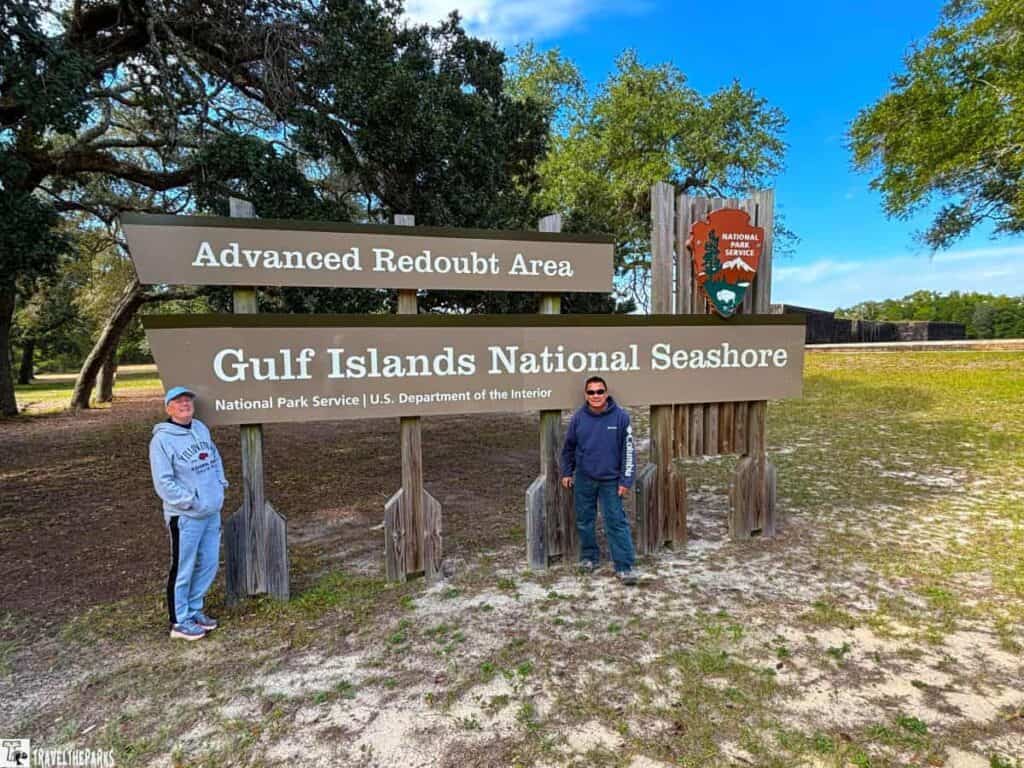
Table of Contents
Getting to the Gulf Islands National Seashore: Fort Barrancas
Driving: Vehicles can access the fort via Highway 98 or Interstate 10. It is located approximately 5 miles west of downtown Pensacola. From downtown, head south on Palafox Street toward Bayfront Parkway. Continue onto Navy Blvd (US-98 West). Turn left onto Bayfront Parkway and continue straight to the junction with Navy Blvd (US-98 West)-6 miles. Turn left onto Fort Barrancas Road. When you see signs for Fort Barrancas, make a left turn onto Fort Barrancas Road.
Flying: The closest airport to Fort Barrancas is Pensacola International Airport, and is located roughly 8-miles from Fort Barrancas. The airport has rental cars available.
Note that Fort Barrancas is on a military base—NASPensacola — and visitors must pass through a security checkpoint to enter. Visitors should bring a valid photo ID and be prepared to undergo a security screening.
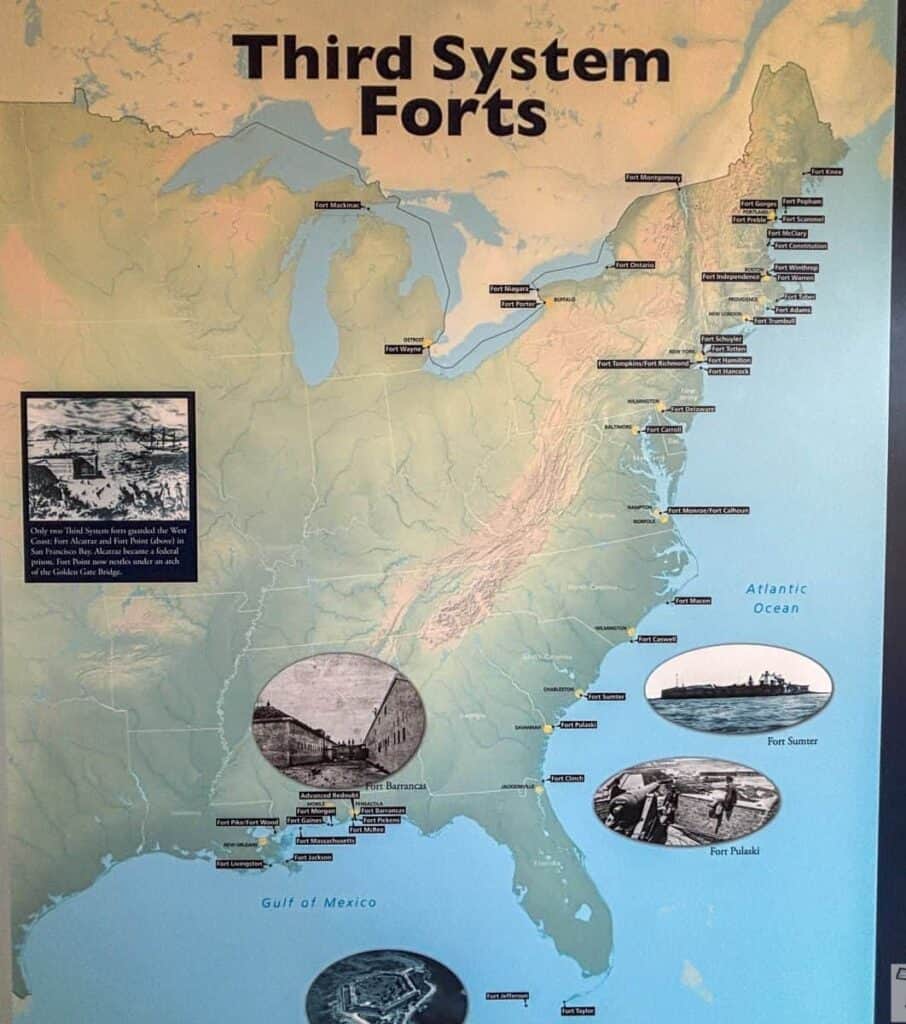
This post may contain affiliate links, meaning if you purchase something through one of these links, we may earn a small commission at no extra cost to you! Read the full disclosure policy here.
What to Know Before You Visit Fort Barrancas
- Location: Fort Barrancas is in Pensacola, Florida, within the Naval Air Station Pensacola. Visitors need to enter through the West Gate. Military ID, Passport or Driver’s License with Real ID for anyone over 16.
- The fort and visitor center are open on Fridays, Saturdays, and Sundays from 9 am–3:30 pm.
- Entrance Fees: Admission to Fort Barrancas is free! There is an honor system at the Gulf Islands National Seashore for $20 per vehicle admission, good for a seven-day pass into all the areas of the park. All Interagency Annual America the Beautiful passes are valid for Gulf Islands National Seashore.
- Attend ranger-led programs: Park rangers offer guided tours, talks, and demonstrations throughout the day, including musket and cannon firings, historic weapons demonstrations, and living history programs.
- Fort Barrancas is pet-friendly! You can bring your furry friend along as long as they are on a leash. Just be sure to keep them on the designated paths.
- Visit the bookstore and gift shop: The bookstore and gift shop at Fort Barrancas offer a variety of books, maps, and souvenirs related to the history and culture of the Gulf Coast and the American South.
- While Fort Barrancas itself doesn’t have any cafes or restaurants, you’ll find a picnic area near the visitor center. Bring a water bottle to stay hydrated, especially in the warmer months.
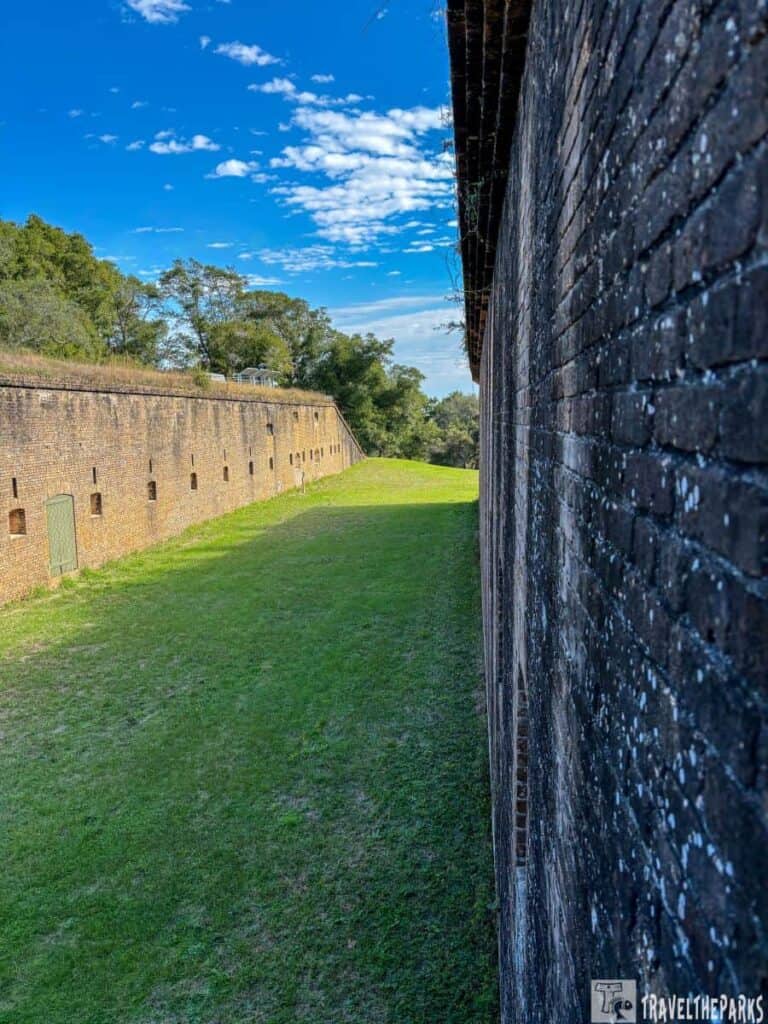
Uncovering the History of Fort Barrancas: From Civil War Battles to Coastal Defense
Built between 1839 and 1844, Fort Barrancas was designed to protect the Pensacola Navy Yard, a critical naval installation. The fort stood on the site of the older Fort San Carlos de Barrancas. Constructed with 6 million bricks, walls 4 feet thick and 20 feet high, it is formidable, to say the least.
Fort Barrancas is quite similar in design, purpose, and construction to other forts built during the Third System, such as Fort Monroe, Fort Pulaski, Fort Sumter, and Fort Pickens. These forts were all designed to defend key coastal areas, especially harbors and naval stations, from potential threats. Their common features—such as star-shaped layouts, thick masonry walls, bombproof shelters, and artillery emplacements—make them exemplary examples of early 19th-century military architecture.

While its primary purpose was defense, Fort Barrancas saw its most significant military action during the Civil War. In 1861, Confederate forces occupied the fort and the nearby Advanced Redoubt, facing off against Union troops holding Fort Pickens across Pensacola Bay. Though the two sides exchanged fire, there was no full-scale battle. Notable Union ships like the USS Niagara and USS Richmond participated in the skirmishes with the Confederate forces at Fort Barrancas.
After the war, the fort remained an important coastal defense site, especially for protecting the vital Pensacola Naval Yard. Authorities decommissioned it during World War II, but it had continued to serve this role until then. Air Force before later being designated a National Historic Landmark in 1978. Today, this historic fort is part of the National Park Service and open to the public for guided tours.
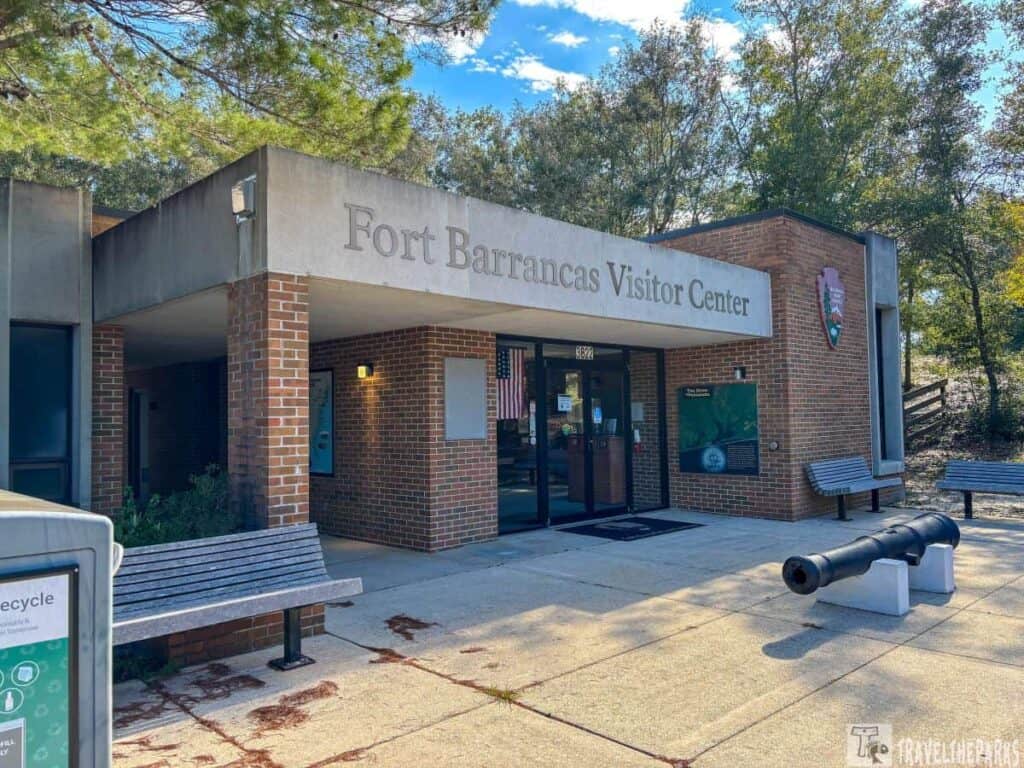
Visitors Center at Fort Barrancas
The visitors center at Fort Barrancas is an essential starting point for anyone exploring this historic site. Located at the fort’s entrance, the visitor center provided a wealth of information and services, enriching our experience and deepening our understanding of the fort’s importance in U.S. military history.
The visitors center has a short, informative film that really gave us an overview of Fort Barrancas’ history. This film was a great introduction to the fort. It provides key events, putting them in historical context before actually going out to explore this fort and its surroundings.
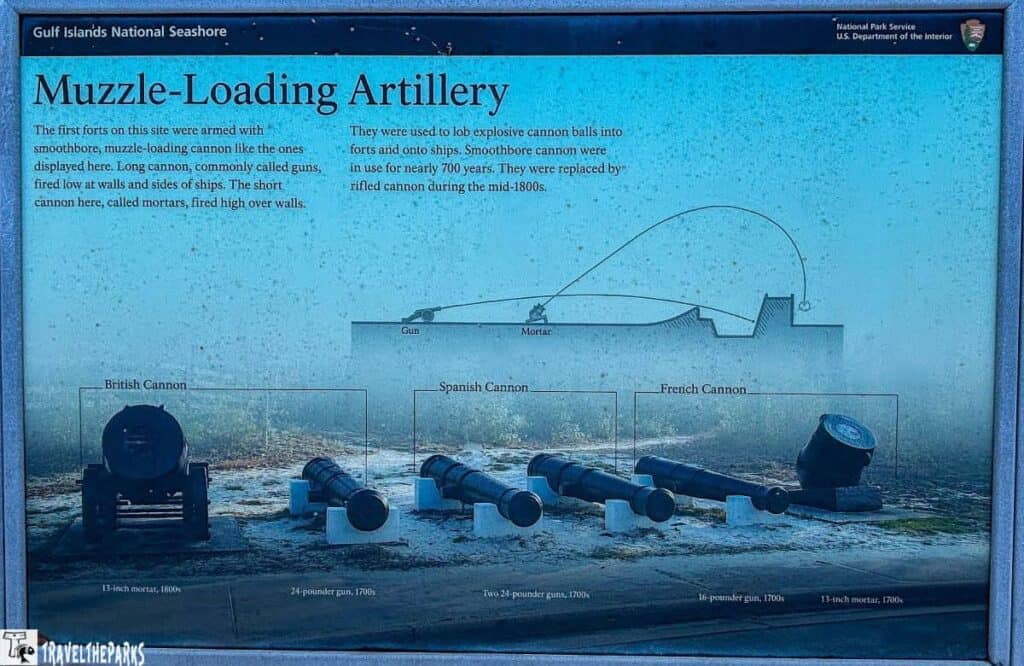
A Morning at Fort Barrancas: Traveling Back in Time
We started our day at Fort Barrancas itself: a historic military fortification that dates back to the early 1800s. As soon as we pulled into the parking lot, we could feel the weight of history in the air. Its position on a bluff above Pensacola Bay gives the fort fantastic views, allowing us to appreciate both its strategic importance.
This fort was active during the Spanish-American War, World War II and also in relation to the general history of the U.S. military. We enjoyed very much learning about the various military strategies and how the fort had to grow with new technologies over the years.
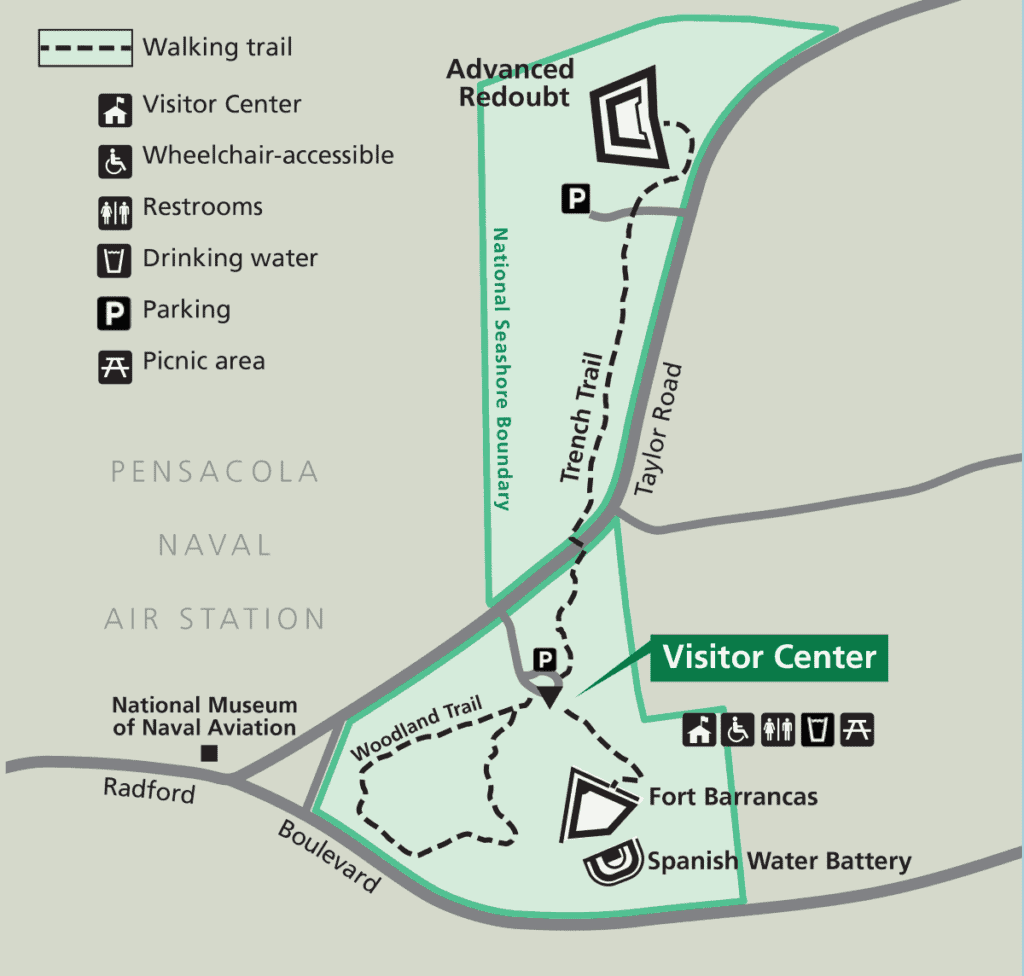
NOTE: When visiting Fort Barrancas in Florida, bring comfortable shoes, water, and snacks. You can also bring sunscreen, a hat, and sunglasses to protect yourself from the sun.
Exploring Fort Barrancas: A Self-Guided Tour Through History
If you are one of those who like taking their time when exploring history, then the self-guided tour of Fort Barrancas is a treat. Be it a history buff or just a person who enjoys a pleasant walk in scenic surroundings, this tour enables one to explore the rich past of the fort at their own pace. You don’t have to hurry through the stations; each has something different to offer. Interactive kiosk signs around the fort do a great job of informing us about the fort’s role. Here’s a sneak peek at what to expect as you wind your way through this fascinating site.
NOTE: If you’re taking your dog to Fort Barrancas, watch out for sand spurs. These pesky plants have sharp spines that can stick to your pet’s paws, fur, or skin. This can cause pain and injury if not addressed quickly. While they’re more common during certain times of the year, it’s best to be vigilant throughout your visit. Keep your pet on a leash and check it regularly to avoid any discomfort. Enjoy your time, but stay alert to ensure your furry friend is safe and happy.
Begin your tour at the main fortification and the centerpiece of the self-guided tour-Fort Barrancas. Visitors can explore the fort’s various rooms, including the casemates, powder magazines, and officers’ quarters.
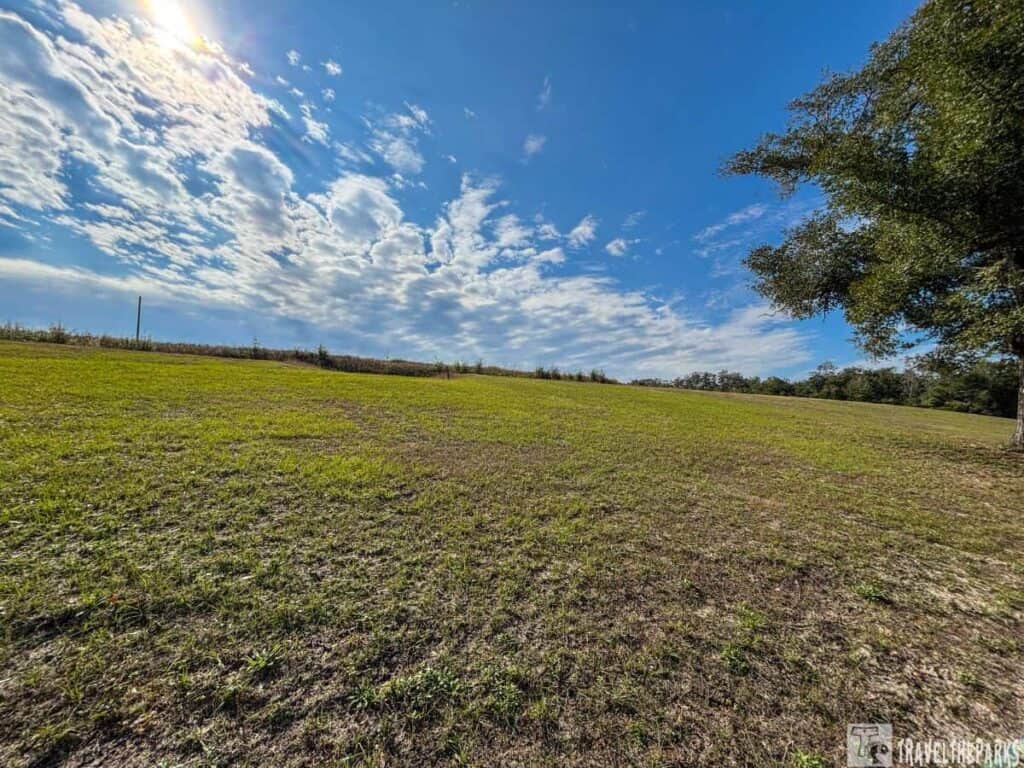
Stop 1 Fort Barrancas Tour: The Glacis
The glacis (glah-SEE) was a key feature of Fort Barrancas. These were sloping earthworks that extended outward from the fort, thus protecting the brick wall. It prevented attackers from easily approaching the walls. Manual laborers initially dug around the fort to lower the ground, forming a slope. This would entail digging into the soil and, where necessary, filling in to achieve and maintain a uniform slope. The workers would use hand tools of spade and pick. Today, the grass-covered area is a pleasant approach to the fort.
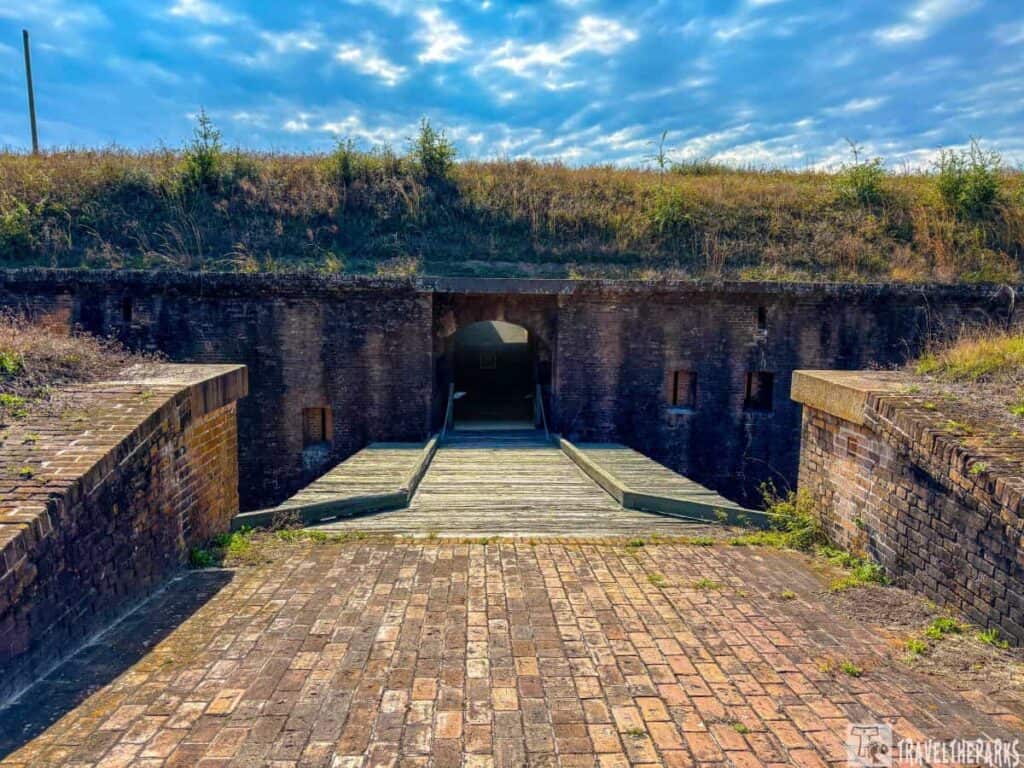
Stop 2 Fort Barrancas Tour: Drawbridge
The drawbridge served as the main entry point to the fort, granting soldiers and supplies safe passage while keeping enemies out. By raising the bridge, the defenders created a gap over the moat, making it tough for attackers to get close. Lowering the bridge allowed controlled access for allies and needed resources. This system gave the fort’s defenders the upper hand in managing who could enter and exit, ensuring better security against potential threats. It was easy to visualize how the fort was protected while imagining how soldiers stationed here would have operated the bridge in various situations.
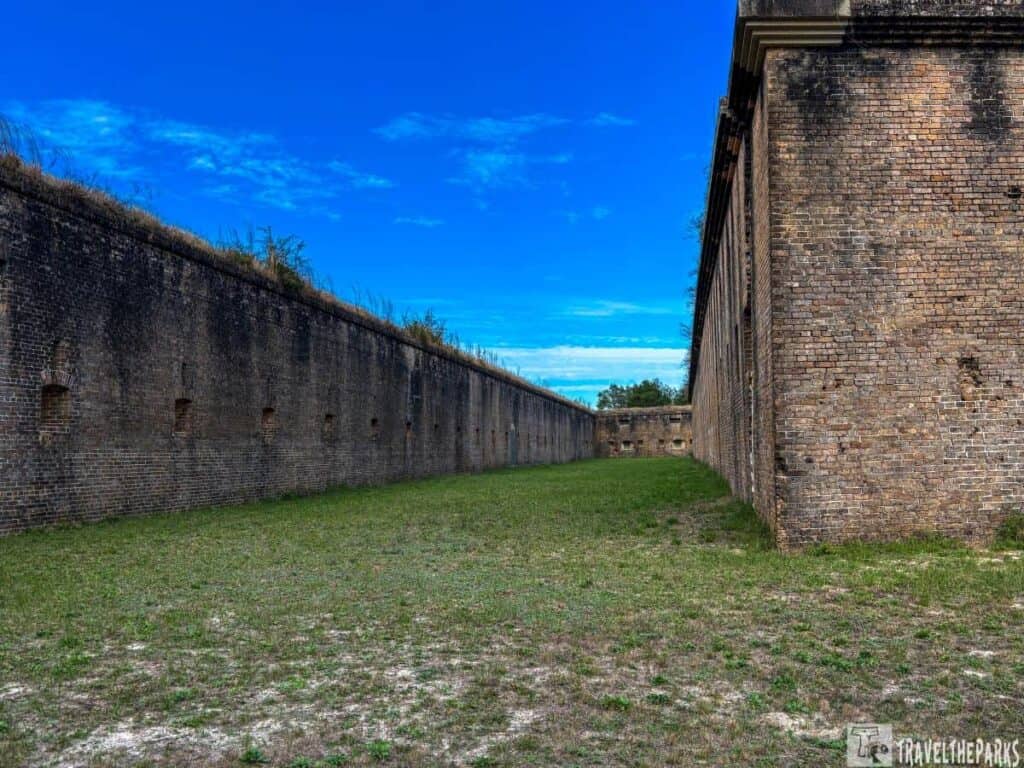
Stop 3 Fort Barrancas Tour: Scarp & Counterscarp
The scarp and counterscarp created a powerful defense around the fort. The Scarp served as the main wall, blocking attackers from easily reaching the fort’s outer walls. Alternatively, the counterscarp added more barriers, making it harder for enemies to advance. Together, they prevented common siege tactics such as tunneling or direct assaults. Any attacking force faced significant challenges, forcing it to engage from a weaker position. This layered defense made the fort much harder to breach. We walked for quite a while around the outer parts, observing the walls’ slopes.
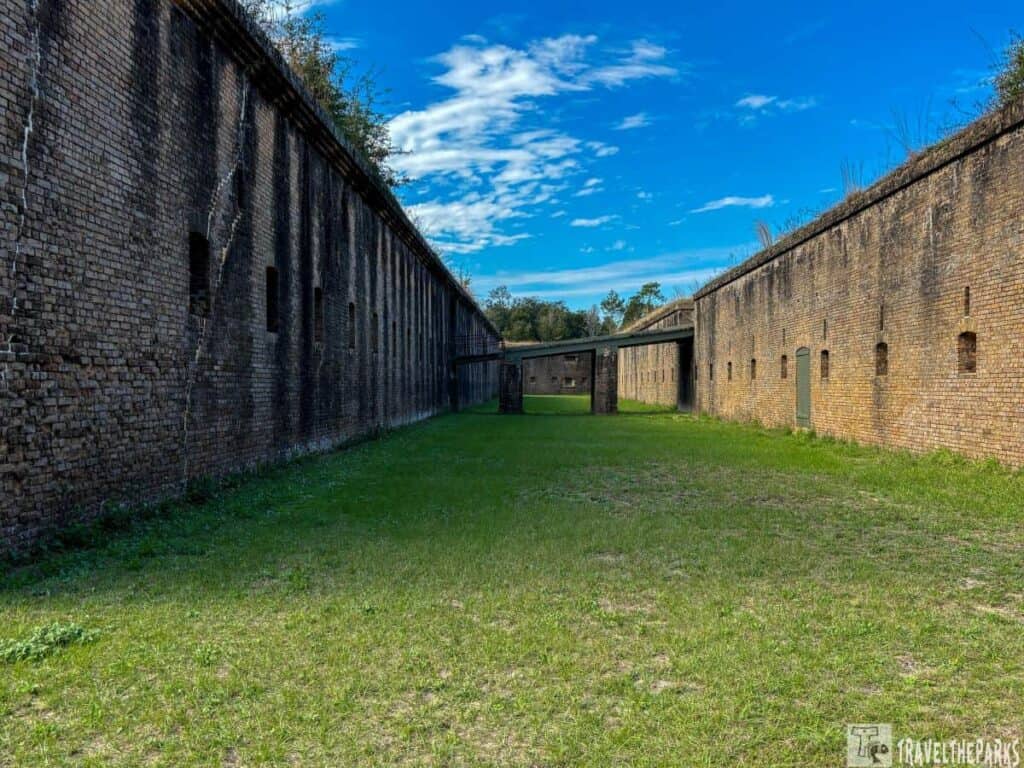
Stop 4 Fort Barrancas Tour: Dry Ditch
The dry ditch, or moat, is a significant defensive feature of Fort Barrancas. This deep trench surrounds the fort, creating a barrier against attackers. It prevents enemy forces from easily reaching the walls, adding to the fort’s defenses. The Dry Ditch was also an important psychological barrier. The very sight of a large trench around the fort made it clear to potential attackers that it would be a costly and difficult effort to breach the walls. It deterred all but the most determined attackers.
As we explored the dry ditch walking along, it helps you imagine the challenges soldiers faced during attacks. It may not be as impressive as a water-filled moat, but it still gives you an excellent sense of the challenges attackers would have faced. The wide trench surrounding the fort creates a clear picture of how the fort’s design worked together to make it harder for enemies to approach.
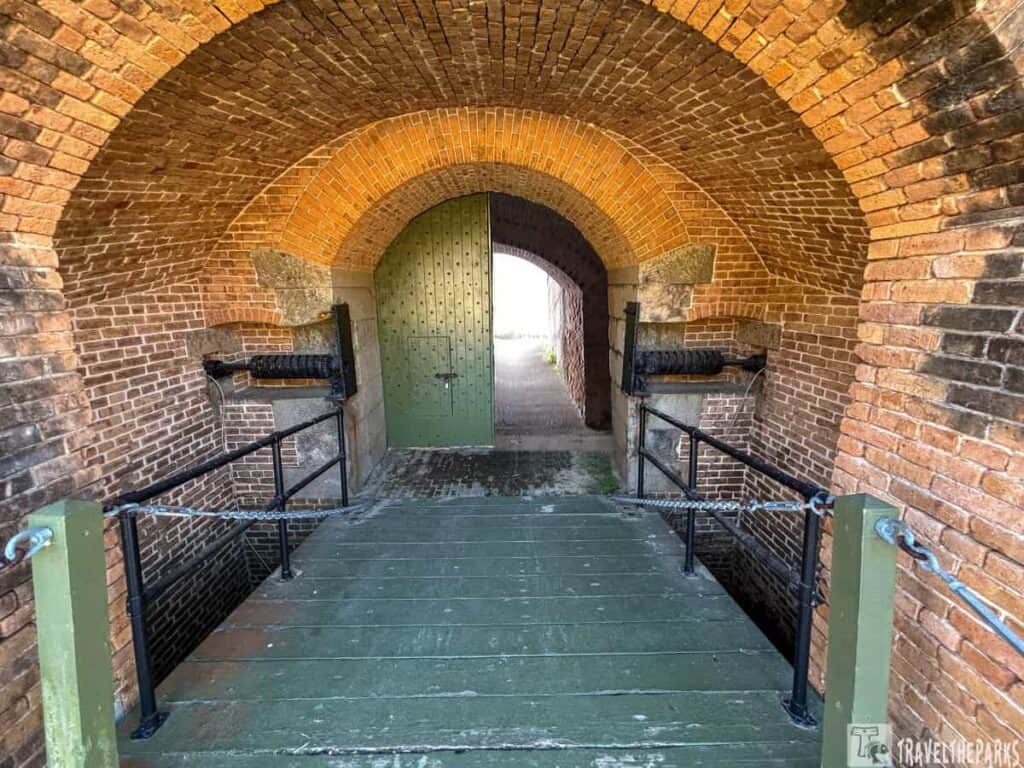
Stop 5 Fort Barrancas Tour: Sally Port
As we approached the entrance to Fort Barrancas, we found a handy overview station that gives you the lay of the land. Here, we got an introduction to the fort’s history and its strategic importance. The US Army constructed the fort in the early 19th century to protect Pensacola Bay. It has played a part in several conflicts throughout its history, including the Civil War and World War II.

Stop 6 Fort Barrancas Tour: Guard Room
The Guard Room was the heart of the fort, vital to its daily operations. Here, soldiers gathered for roll call, receiving their orders and marching out to their posts. Among the troops tasked with protecting the fort and its surroundings, this central space enforced discipline and organization. It served as a hub of preparation and coordination, ensuring the safety of both personnel and the area beyond the walls. The Guard Room was a crucial command center, maintaining order and readiness across the entire garrison.

Stop 7 Fort Barrancas Tour: Scarp Gallery
The Scarp Gallery played an essential role in the fort’s defense. Built into the steep outer slope, it allowed soldiers to move safely between areas of the fort. This design minimized their exposure to enemy fire, enhancing the fort’s overall security. By connecting different sections, the gallery improved troop movement and response during an attack. Its unique structure was key to fortifying the fort against threats.
The highlight of the place for us was wandering these underground tunnels. These cool, dimly lit corridors offered a glimpse into life below the surface, and we could almost hear the footsteps of soldiers from the past echoing in the quiet.
Stop 8 Fort Barrancas Tour: Counterscarp Gallery
The gallery acted like the scarp, offering soldiers a safe spot while defending the fort’s outer walls. It provided a high ground for defenders to see and target attackers trying to cross the dry ditch or break through the fort’s perimeter. The design included openings for cannons and other weapons, allowing soldiers to fire effectively. Positioned here, they could unleash powerful attacks on enemies trying to scale the scarp or approach the fort’s entrance. This strategic advantage helped secure the fort during attacks. The gallery features impressive brickwork and narrow passageways.
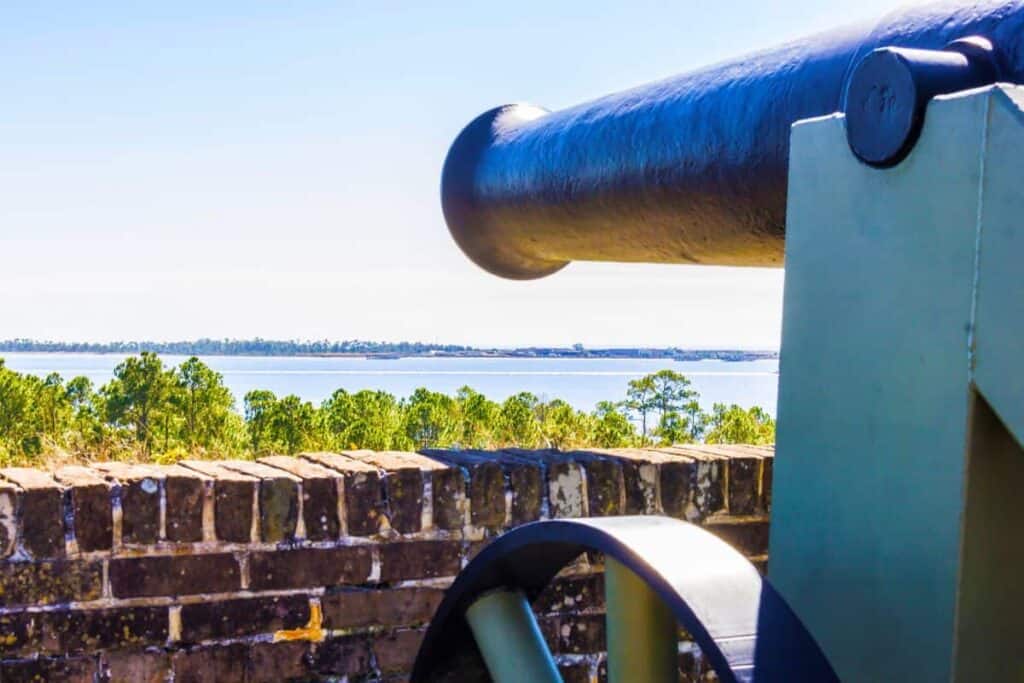
Stop 9 Fort Barrancas Tour: Parade Ground
The parade ground at Fort Barrancas offers a significant glimpse into military life. This open area once hosted drills, ceremonies, and parades. Visitors can imagine soldier’s training and preparing for duty. The surrounding historic walls echo stories of the past. It serves as a reminder of the fort’s role in defending the area. The grassy field invites exploration and reflection. It’s an ideal spot for photos or a quiet moment in history. Enjoying the site helps connect with the military heritage of the region.
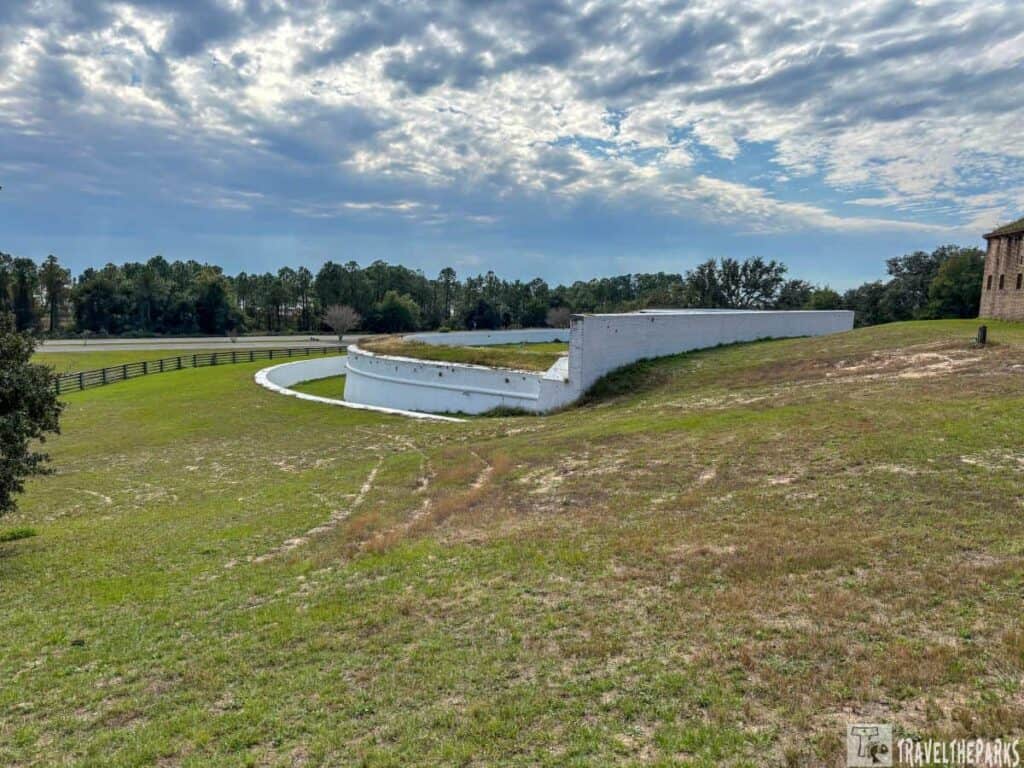
Stop 10 Fort Barrancas Tour: Spanish Water Battery
I found this to be pretty interesting, unlike anything we have explored before. The Spanish Water Battery, constructed in the early 1800s, represents the strategic importance of Pensacola Bay. Positioned at the entrance of the bay, it was intended to guard the harbor, Fort Barrancas, and other military installations against naval attacks. Being a significant trading and military center, the protection of the bay was essential for regional control. Even after the U.S. acquisition of Florida in 1821, the battery remained part of the coastal defenses of Pensacola, playing a very important role in several conflicts against British and Confederate forces, including the War of 1812 and the Civil War. interpretive panels around the site help explain the history of the battery, including its construction, purpose, and role during key conflicts.
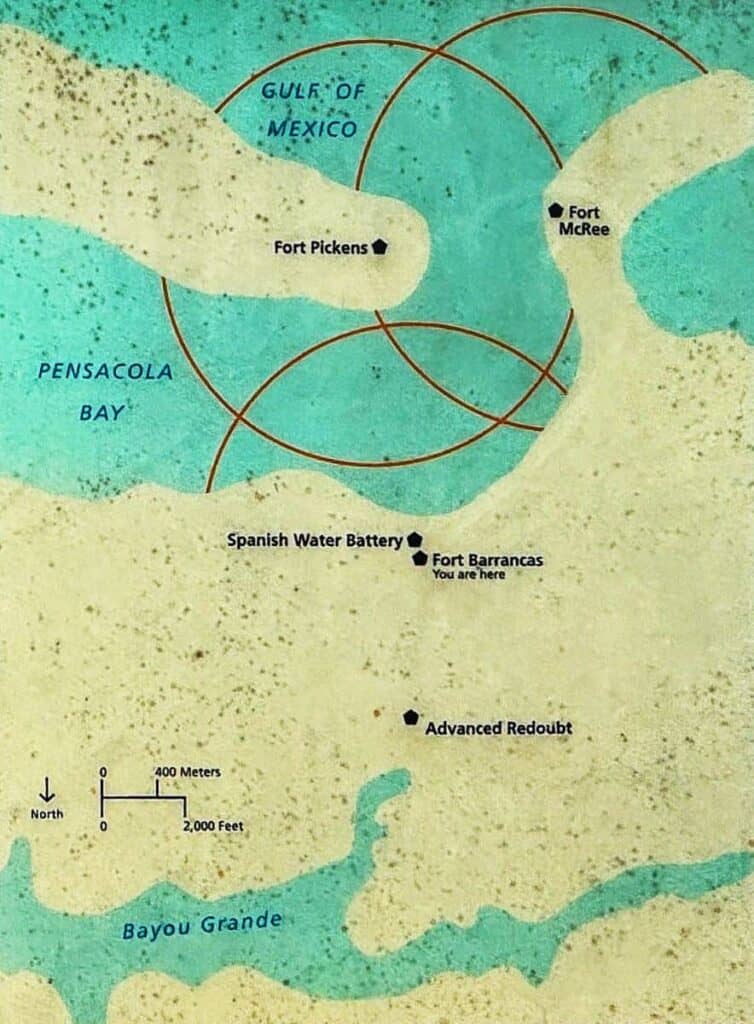
Trench Trail: Remnant of the Barrancas Trench
This 0.5-mile Trench Trail is more than just a simple path – it’s a historical corridor that transports us through the same terrain once traversed by soldiers during a time of intense conflict between Union and Confederate forces in Pensacola.
In 1863, a group of 60 U.S. soldiers toiled in grueling six-hour shifts, around the clock, to dig this strategic trench in front of a breast-high wall. Their backbreaking labor, carried out under harsh conditions, was critical to fortifying the area and protecting Fort Barrancas from any advancing Confederate troops.
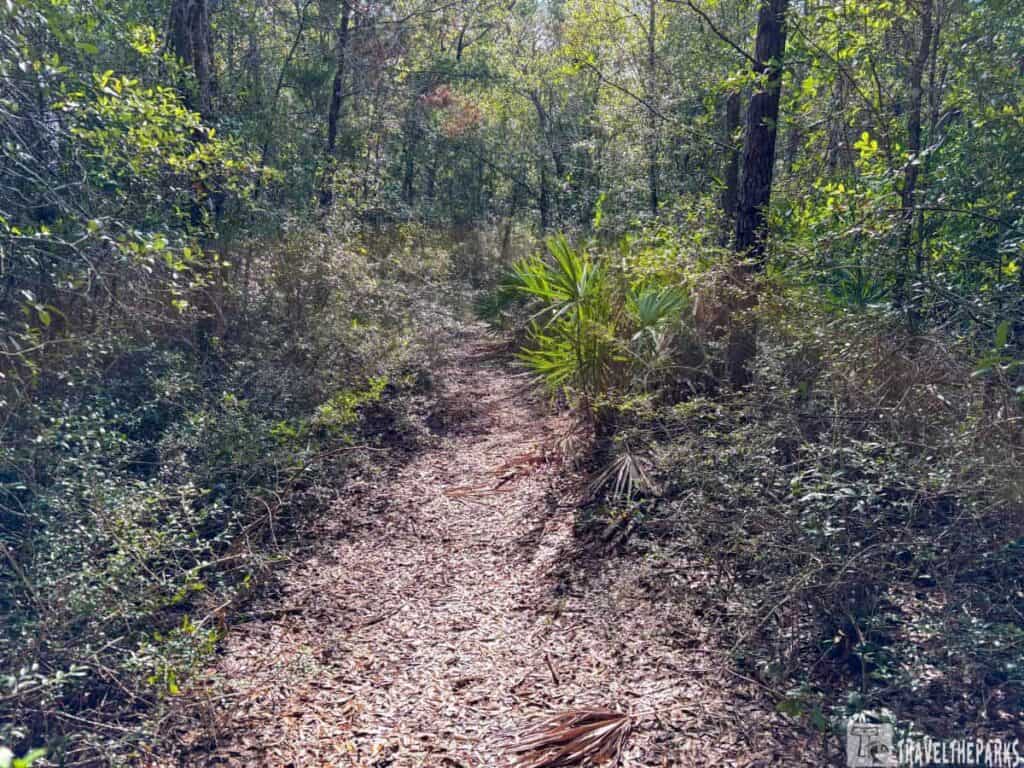
The trench served a twofold purpose – it provided cover for the defenders to move along it without full exposure, and it slowed the progress of enemy forces trying to overrun the position. This clever combination of trench and breastwork made it significantly harder for the Confederates to break through the Union lines.
As we walk this stretch of the Trench Trail, we can almost feel the footsteps of those soldiers who had to defend the area from both land and sea. This trail is a tangible link to a pivotal moment in history. One thing to note is in the warmer months, insect repellant would be a good idea for the mosquitoes.
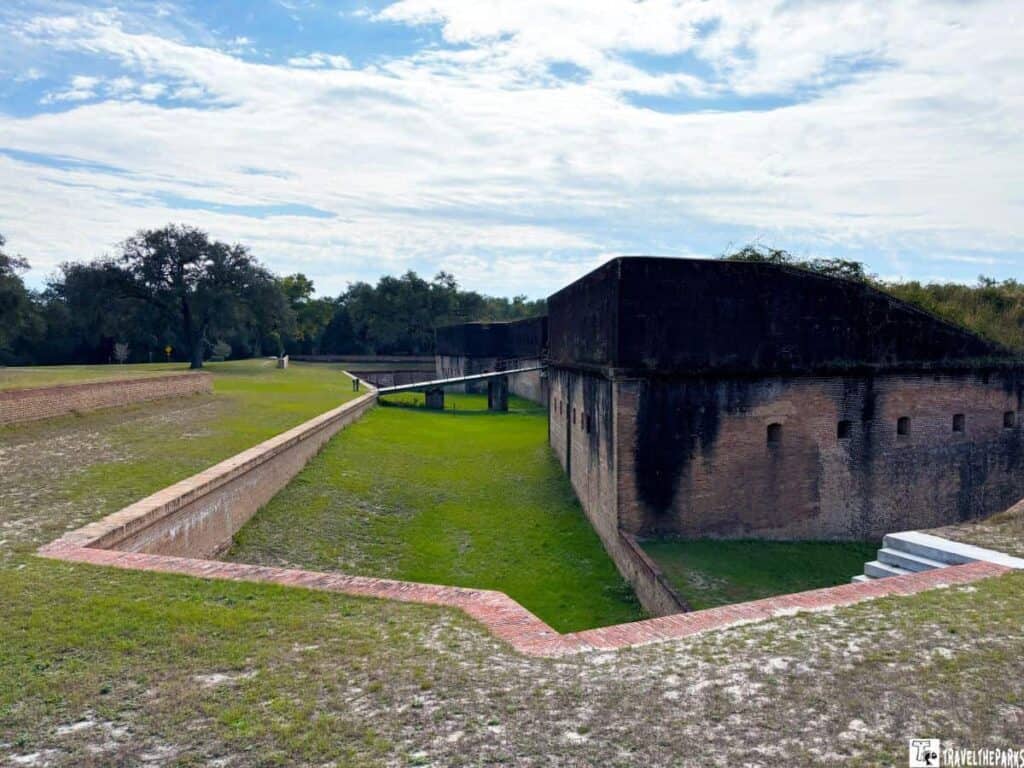
Fort Barrancas National Historic Site: Advanced Redoubt Self-Guided Walking Tour
They built the Advanced Redoubt in the mid-1800s, alongside Fort Barrancas. This smaller fortification served as an extra layer of defense. Positioned north of Fort Barrancas, it aimed to slow down enemy forces before they reached the main fort. The Advanced Redoubt enhanced military strategy by providing support and coverage during potential attacks. Its location allowed for better control of the surrounding area, making it a vital part of the defense system.
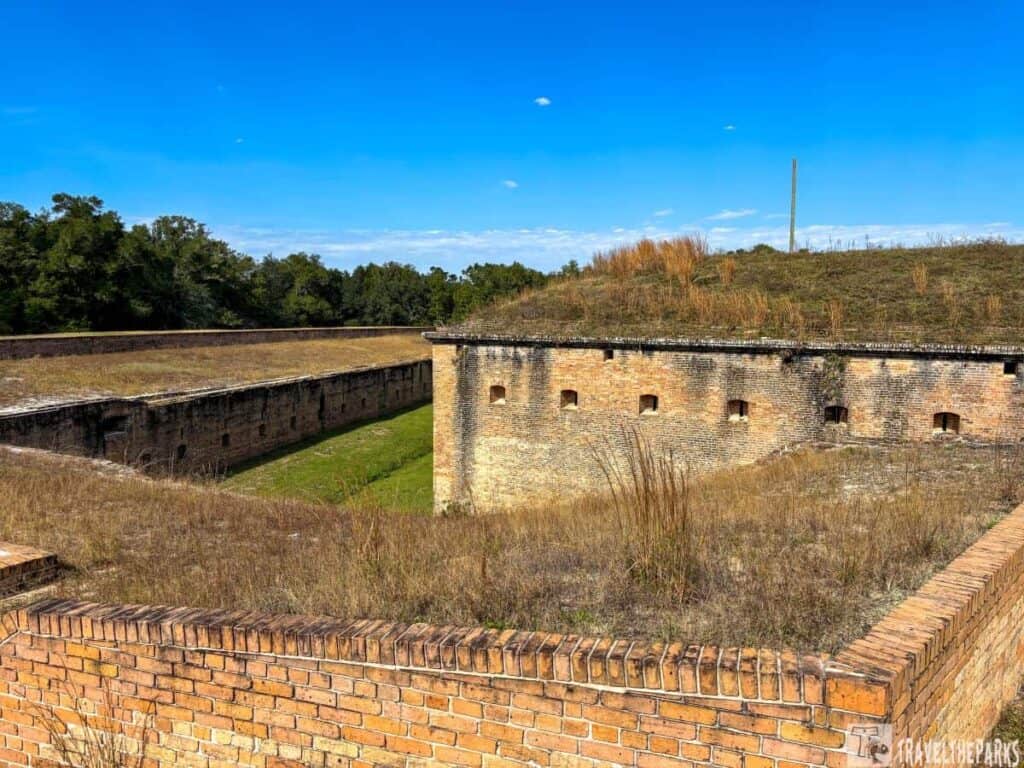
Advanced Redoubt Self-Guided Stop 1: The Glacis
The Glacis-As we approach the first stop, The Glacis, we’re struck by the broad, sloping earthwork that stretches out from the redoubt. This gentle incline was designed to create a clear field of fire, enabling defenders to spot and target any approaching enemy soldiers or artillery. Though the scene appears tranquil now, it’s easy to imagine the chaos of the Civil War era, when this open space would have provided a strategic advantage for the fort’s defenders. Standing here, we can almost hear the distant rumble of cannon fire or the march of troops, each step carrying us deeper into the past.
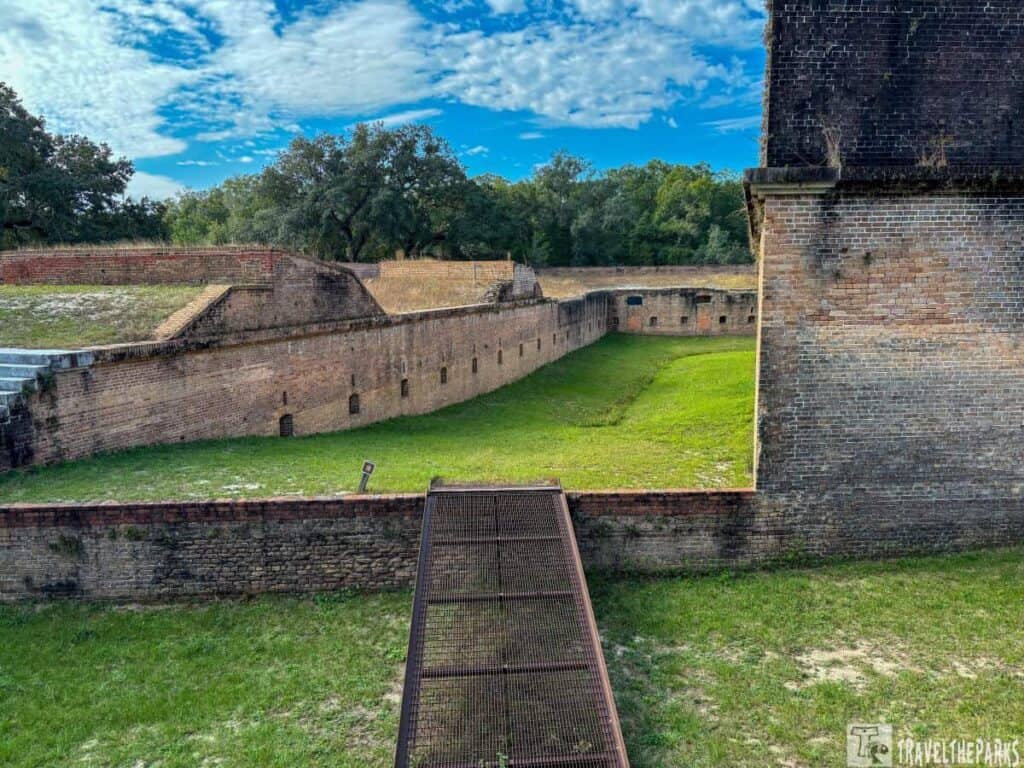
Advanced Redoubt Self-Guided Stop 2: The Traverses
We make our way to the Traverses, the next stop on the tour. These raised earthen embankments stretch out before us, easy to picture soldiers moving along them, seeking cover from enemy fire. The traverses were essential for protecting the soldiers at the redoubt, especially those manning the cannons and heavy artillery. The layout was designed to shield defenders from incoming shots by curving in strategic patterns while allowing them to fire at advancing forces. Standing in their shadow, it’s surreal to imagine crouching behind the earthworks, watching the smoke and chaos of battle unfold.
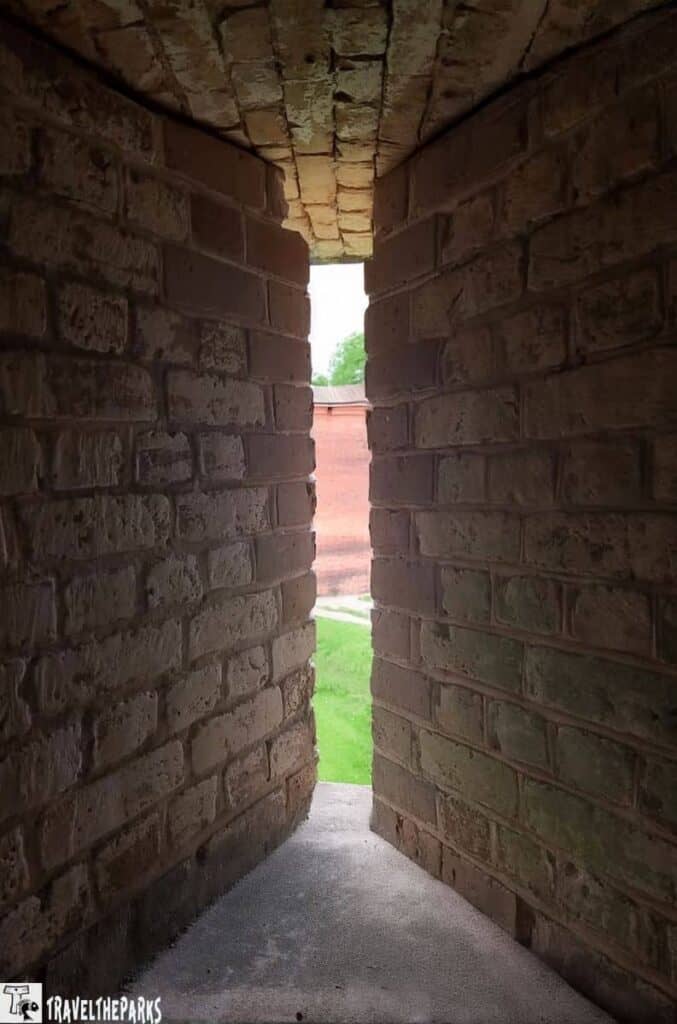
Advanced Redoubt Self-Guided Stop 3: The Dry Ditch
Centuries ago, the Dry Ditch would have been a formidable barrier, filled with obstacles and even water to deter enemy assaults on the fort. Today, it stands as a quiet, sunken trench—but in its heyday, any attackers would have had to cross this perilous chasm while exposed to fire from the fort’s defenders. As we peer into the ditch, we can almost feel the tension of the past, picturing soldiers desperately trying to scale the walls or scramble across while under heavy fire.

Advanced Redoubt Self-Guided Stop 4: Wall Pitting
The weathered walls of Wall Pitting bear the scars of centuries of conflict. Pitted and scarred, the redoubt’s ramparts testify to both natural erosion and the damage of artillery fire. These craters serve as reminders of the fort’s strategic importance during the Civil War, when Confederate and Union forces exchanged fire across the bay. The Union’s naval bombardments have left some aimed at weakening the fort’s defenses. Walking along the walls and examining the pitting up close, we can almost feel the intensity of those bygone battles, as if the very stone echoes the tumult of those turbulent times.
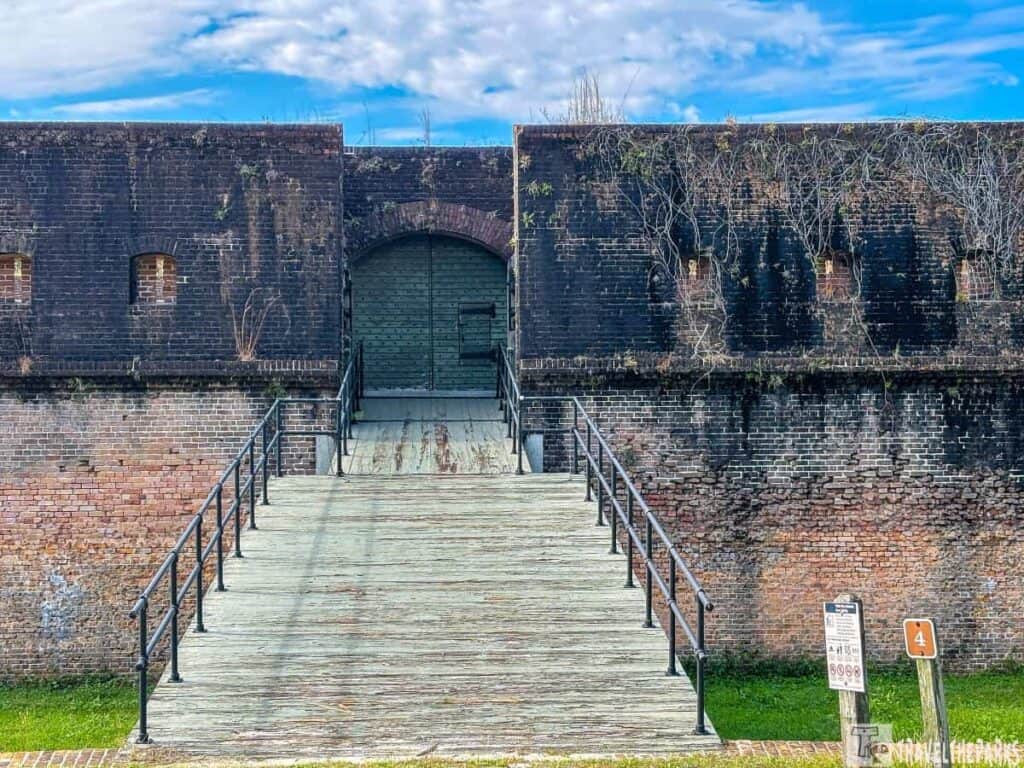
Advanced Redoubt Self-Guided Stop 5: The Drawbridge
Last we approach Stop 5, The Drawbridge, a key feature in the fort’s layered defenses. Standing before it now, it’s hard to imagine the tension that surrounded this seemingly simple feature. Drawing up the bridge would cut off any approaching enemy, forcing them to find another way in or out. The dry ditch we saw earlier would have amplified the drawbridge’s defensive role by preventing direct access to the fortifications.
The heavy chains and counterweights used to raise and lower the bridge are long gone, but we can picture the soldiers working urgently to pull the ropes and lift the bridge just in time to prevent an attack. Today, the structure is quieter, but we feel the essential role this point of entry would have played in a siege.
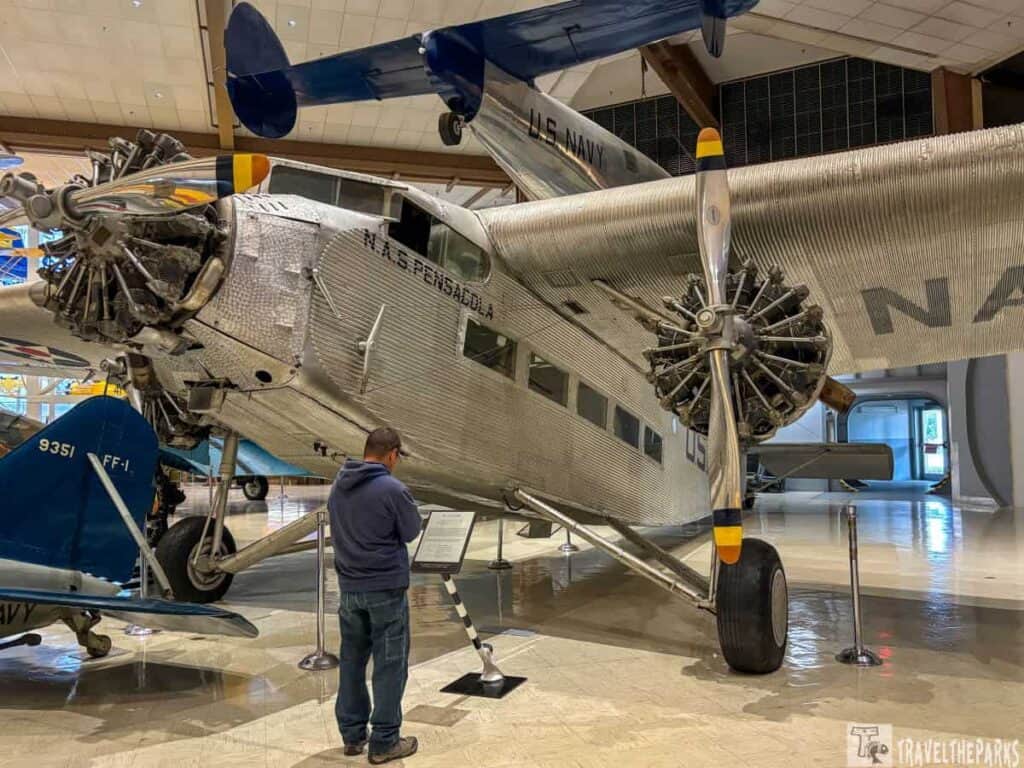
Pensacola National Aviation Museum: Flying Through Time
The next stop was the National Aviation Museum, just a short drive from the fort. This museum is a treasure for anyone who loves naval air history and craftsmanship. Stepping inside, the rich history of flight surrounds you. Visitors can explore countless exhibits, showcasing everything from vintage biplanes to modern fighter jets. Each display tells a story, highlighting the journey of aviation technology and design. Interactive features engage all ages, making learning enjoyable. The museum stands out as a vital experience for those interested in aviation’s fascinating legacy.
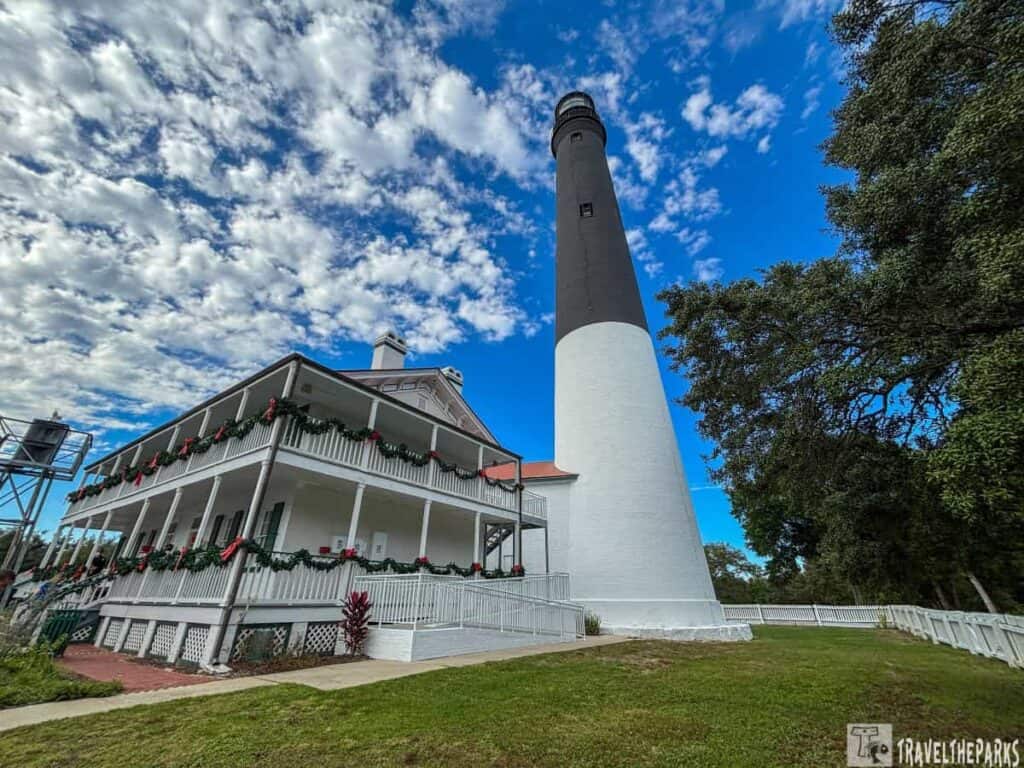
A Short Drive to the Pensacola Lightouse: A Beacon of History
After a quick drive from the Naval Air Museum, we arrived at the Pensacola Lighthouse. This landmark has stood proud since 1859, guiding ships safely into the bay. The striking contrast of its white tower against the blue sky is mesmerizing. We were eager to climb to the top, even though the ascent involved 177 steps. It’s a challenge, but reaching the top rewards you with an incredible view. The turquoise Gulf waters stretched out before us, filled with boats and ships, while the coastline seemed endless. Sitting there in the warm breeze, we reflected on the rich history this lighthouse has witnessed in maritime times.

Wrapping Up the Day: A Relaxing End
After a day filled with history and exploration, we took time to unwind at one of the nearby beaches. The Gulf Islands National Seashore boasts stunning views and clean sand. We quickly found a peaceful spot to sit and watch the sunset. Each adventure made us appreciate the beauty around us even more.
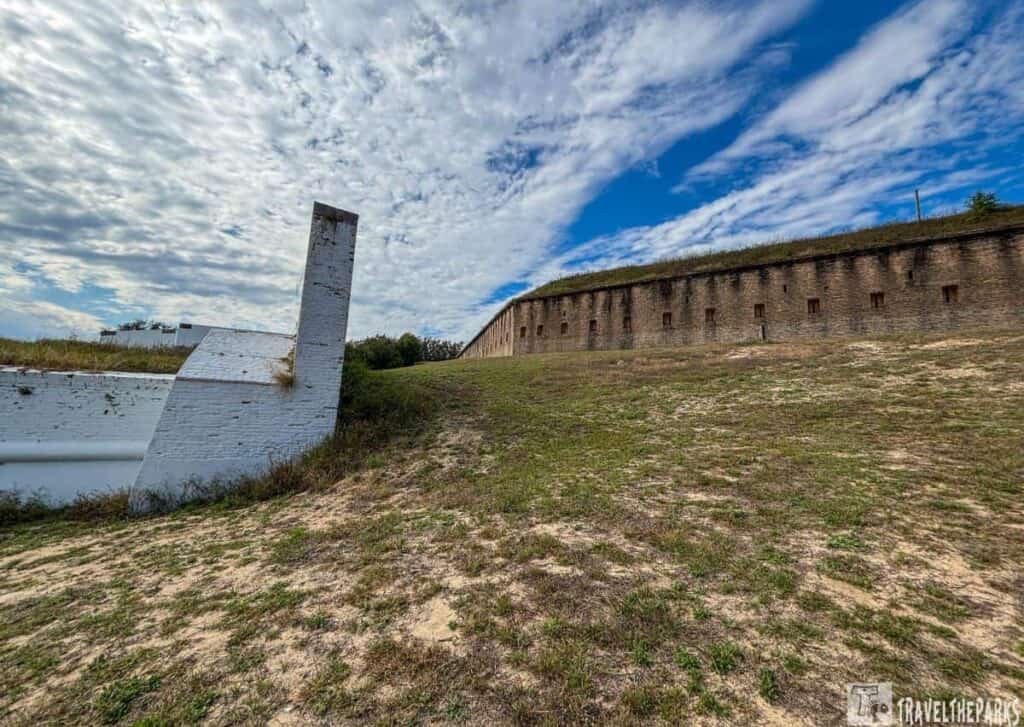
Final Thoughts: Exploring Fort Barrancas: A Must-Visit Historic Site in Florida
Fort Barrancas and its attractions offer a mix of history and natural wonders that appeals to everyone. This day was a blend of learning and enjoyment, creating memories we’ll cherish. If you’re heading to Pensacola, set aside time to check out these amazing places; it’s an experience worth having. Keep exploring. For us, whether it’s a hidden trail or a historic building, each visit adds to our understanding of the world. These moments spent exploring fuel our curiosity and create lasting memories. It’s these experiences that connect us to our surroundings and ignite a deeper appreciation for the beauty of our environment.
Have you had the opportunity to visit this magnificent fort? What historic takeaway did you have? Share your impressions with us in the comments below.

